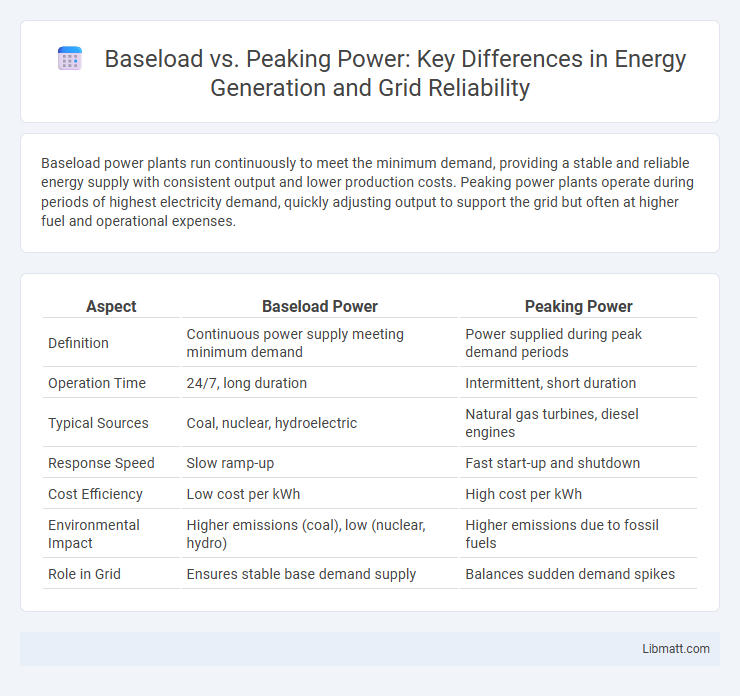Baseload power plants run continuously to meet the minimum demand, providing a stable and reliable energy supply with consistent output and lower production costs. Peaking power plants operate during periods of highest electricity demand, quickly adjusting output to support the grid but often at higher fuel and operational expenses.
Table of Comparison
| Aspect | Baseload Power | Peaking Power |
|---|---|---|
| Definition | Continuous power supply meeting minimum demand | Power supplied during peak demand periods |
| Operation Time | 24/7, long duration | Intermittent, short duration |
| Typical Sources | Coal, nuclear, hydroelectric | Natural gas turbines, diesel engines |
| Response Speed | Slow ramp-up | Fast start-up and shutdown |
| Cost Efficiency | Low cost per kWh | High cost per kWh |
| Environmental Impact | Higher emissions (coal), low (nuclear, hydro) | Higher emissions due to fossil fuels |
| Role in Grid | Ensures stable base demand supply | Balances sudden demand spikes |
Introduction to Baseload and Peaking Power
Baseload power refers to the minimum continuous level of electricity demand that must be met by power plants operating steadily, often supplied by coal, nuclear, or hydroelectric sources due to their reliability and low operational costs. Peaking power, on the other hand, addresses the fluctuations in electricity demand during peak usage periods, commonly provided by natural gas turbines or diesel generators because of their ability to start quickly and adjust output rapidly. Understanding the distinct roles and operational characteristics of baseload and peaking power plants is essential for optimizing grid stability and efficiency.
Defining Baseload Power: Characteristics and Sources
Baseload power refers to the minimum constant level of electricity demand on the grid, supplied continuously by power plants with high reliability and low operational costs. Key characteristics include steady output, high capacity factors, and low fuel price volatility, making sources like nuclear, coal, and large-scale hydroelectric power dominant in this category. These power sources ensure grid stability by providing a continuous electricity supply essential for meeting the baseline consumption needs.
What Is Peaking Power? Key Features and Types
Peaking power refers to the electricity generated during periods of highest demand, often supplied by fast-startup power plants like gas turbines or hydroelectric units. Key features include rapid response times, high operational flexibility, and typically higher production costs compared to baseload power. Common types of peaking power plants are open cycle gas turbines, battery storage systems, and pumped hydro storage facilities.
Major Differences Between Baseload and Peaking Power
Baseload power plants provide a continuous and stable supply of electricity, operating at a constant output to meet the minimum demand on the grid, typically fueled by coal, nuclear, or hydroelectric sources. Peaking power plants, often powered by natural gas turbines or diesel engines, are designed to quickly ramp up electricity production during periods of high demand, known as peak times, but run less frequently due to higher operational costs. Your understanding of these major differences helps optimize energy planning by balancing reliability and cost-efficiency in power generation.
Role of Baseload Power in Grid Stability
Baseload power provides a continuous and reliable energy supply, maintaining grid stability by meeting the minimum demand consistently. It supports the integration of variable renewable sources by ensuring a steady voltage and frequency, crucial for preventing blackouts. Your energy system relies on baseload plants like coal, nuclear, or hydro to create a stable foundation for the overall power grid.
Importance of Peaking Power During Peak Demand
Peaking power plants play a critical role in maintaining grid stability by supplying electricity during periods of peak demand when baseload power plants cannot meet the sudden surge. These plants are designed for rapid ramp-up and flexibility, ensuring reliable energy availability and preventing blackouts. Your energy system benefits from peaking power by efficiently managing demand fluctuations and supporting consistent power delivery.
Common Energy Sources for Baseload vs Peaking Power
Baseload power commonly relies on consistent energy sources such as coal, nuclear, and large-scale hydroelectric plants, which provide a steady and reliable electricity supply. Peaking power, on the other hand, typically uses natural gas turbines or diesel generators due to their ability to quickly ramp up production during periods of high demand. Understanding these differences helps optimize your energy strategy by balancing cost and reliability in power generation.
Economic Considerations: Cost and Efficiency Comparison
Baseload power plants provide continuous electricity at lower production costs due to high efficiency and stable fuel use, making them economically favorable for meeting constant demand. Peaking power plants incur higher operating costs due to rapid start-up times and reliance on more expensive fuels, but their flexibility is essential for managing peak electricity loads. Your energy strategy should balance these cost and efficiency differences to optimize overall grid economics.
Impact of Renewables on Baseload and Peaking Strategy
The integration of renewables, such as solar and wind, significantly reduces reliance on traditional baseload power plants by providing variable, clean energy during peak production periods, leading to more flexible grid management. Peaking power plants increasingly serve as critical backup resources to balance intermittent renewable generation, responding rapidly to fluctuations and ensuring grid stability. This shift drives a strategic emphasis on fast-ramping natural gas turbines and energy storage solutions to complement the fluctuating output from renewables.
Future Outlook: Evolving Power Generation Mix
The future power generation mix increasingly favors renewable energy sources, reshaping the roles of baseload and peaking power plants. Baseload power, traditionally supplied by coal and nuclear plants, faces competition from advanced energy storage and flexible grid resources that support the variability of solar and wind generation. Your energy strategy must adapt by integrating smart technologies and demand response to balance the grid efficiently as peaking power plants become more dynamic in managing short-term demand spikes.
Baseload vs Peaking Power Infographic

 libmatt.com
libmatt.com